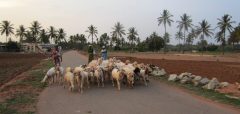Mahatma Gandhi National Rural Employment Guarantee Act (MGNREGA) is a major scheme through which development activities are implemented at the Gram Panchayat (GP) level. In the year 2010, everyone in Honnethalu GP of Shivamogga district in the Western Ghats region of Karnataka was expecting the newly elected GP members to use the scheme to fulfil their election promises.

Honnethalu GP office
Even before the newly elected body took office, the Shivamogga Zilla Panchayat (ZP) had prepared a plan of planting 1.25 crore saplings as part of its massive afforestation campaign through MGNREGA. Thus, the administrator for Honnethalu GP, appointed by the ZP during the time of GP polls had already accepted the target of planting about 65,000 saplings in the GP, before the end of the rainy season in 2010. The implicit rule was to achieve the afforestation targets first and then think about other works. I was recruited as Panchayat Development Officer (PDO) of Honnethalu during this period.
Planting such large number of saplings in the Western Ghat area through MGNREGA was difficult. The GPs were already in the midst of forests and villagers weren’t amused to be involved in planting more saplings. The idea of afforestation was good in principle but was in conflict with local ecology, priorities and interests.
However, there were additional complexities. First, there was just not enough saplings of local varieties. Close to 80% of the sapling supplied were Acacia (Acacia auriculiformis). Mono-species planting of Acacia auriculiformis (also Eucalyptus and Acacia mangium) has been highly controversial. While these trees grow fast and provide paper pulp, firewood and timber, their effects on local environment is deleterious. It is argued that such plantations destroy local biodiversity of flora and fauna as well as deplete the ground water levels in the region. Hence, while prioritizing afforestation was commendable, the way in which it was implemented gave serious doubts on the usefulness of such a massive attempt.
There were justifications other than afforestation, for choosing the species. The forest department officials knew that villagers cut Acacia trees in forest department’s lands for timber and firewood but were less worried about it because the ‘actual forests’ remained untouched. They believed that the scheme really serves the people by creating ample availability of Acacia in the vicinity of villages so as to preserve the diversity of the Western Ghats.
While I was still conflicted on the usefulness of Acacia, I was still responsible for achieving the magic figure of 65,000. With lack of community support, even half the target had not been reached and I was worried. This is when the GP members came up with an ingenious idea to provide saplings to individuals so that at least half an acre of their land could be planted with Acacia. The GP members explained that the plantation would be promoted as ‘free fixed deposits’ for farmers. Each farmer gets 200 plants and 20 days of work under MGNREGA and this investment from the GP would fetch anywhere between Rs 3 lakhs to Rs 5 lakhs in the next 8 – 10 years for the individual. This made complete social and political sense! The GP members enthusiastically identified close to 100 families who would benefit from this initiative. A temple complex which could accommodate close to 15,000 saplings was also identified. The ZP gave permissions to grant saplings to individuals and temples. Lo and behold, the afforestation scheme was a big hit. People came in autos, cars and even trucks to lift the saplings from the GP premises to their households. Those who did not have lands planted the saplings in their backyards.

Acacia planting in the rains
By December, the afforestation targets were reached and other works preferred by the villagers were taken up. This was a classic case of a government scheme, meant to be planned and implemented bottom up but enforced from above. Honnethalu ended up as one of the few GPs to reach their planting targets as well as spending the highest amount on unskilled labor in the block in that year. However, the question still remains: is this really afforestation or rural development?
(Note: Government of Karnataka faced considerable resistance against large scale planting of Acacia and Eucalyptus from environmentalists and local communities. Since 2011, it has banned planting these varieties in government and public lands.)
sham.kashyap@apu.edu.in
